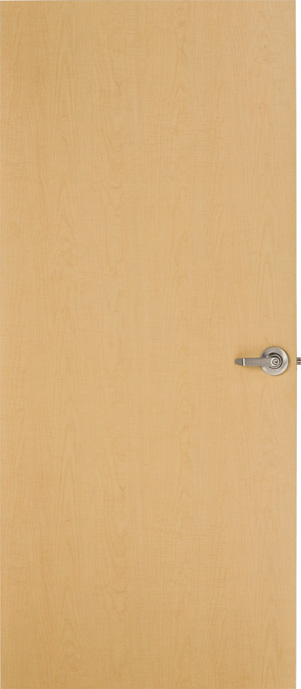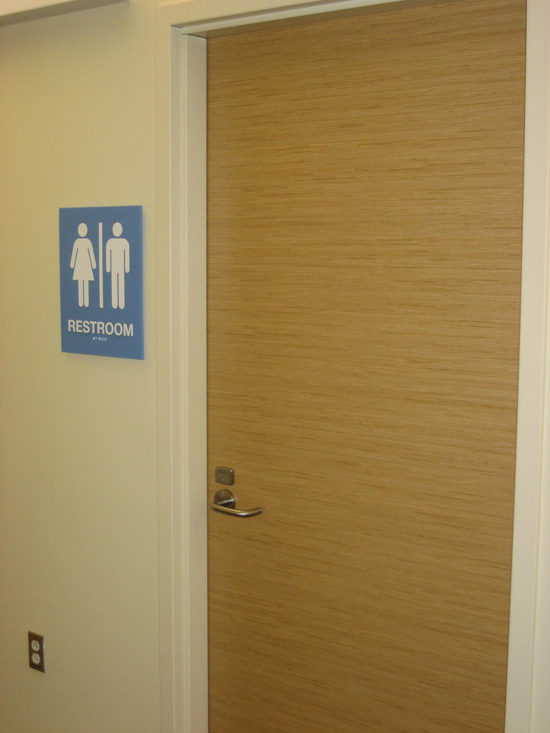Doorway to Distinctive Design
High-Pressure Decorative Laminate—What is it?
The primary difference between laminate-clad wood doors and wood veneer-faced doors is simply the face material. With technological improvements in manufacturing and materials, today's high-pressure decorative laminates (HPDL) are becoming an increasingly popular door surface application. These doors offer myriad design choices, cost benefits, performance achievements, and environmental attributes. Compared to laminate doors from earlier times, today's versions feature improvements in virtually every element and process, with the results including more detailed patterns, smoother surfaces, stronger bonds to substrates, advanced resin surface chemistry for easier maintenance, manufacturing processes that prevent delamination of edges, and increased recycled content.

With technological improvements in manufacturing and materials, today’s high-pressure decorative laminates are becoming an increasingly popular door surface application.
Laminate-clad wood doors are available in high- and low-pressure versions. High-pressure decorative laminate (HPDL) is comprised of several layers of brown kraft paper filled with phenolic resin for flexibility and a high-quality decorative print paper impregnated with melamine resin or an overlay dipped in melamine for strength and durability. They are compressed under high pressure and heat for an extended period of time, approximately 1400 psi at 300° F for up to 40 minutes. The number of kraft/phenolic layers in each sheet of HPDL determines its thickness. In the actual process, the raw paper is first dipped in a resin bath and dried, and the laminate is then assembled with kraft paper and melamine-treated decorative paper or overlay; a textured metal plate then determines the finish properties. The bottom layer of kraft paper is sanded to provide proper adhesion between the laminate and a substrate material. For best results, door edges, which are usually finished with the same laminate as the face, must be applied first to reduce the potential for chips and to hide the seams. When designers opt to have the edges painted or stained, factory finishing almost always provides the best outcome for a look that is both polished and consistent.
HPDL Standards
Performance standards for HPDL are established by the American National Standards Institute/National Electrical Manufacturers Association (ANSI/NEMA), and HPDL must meet Standard LD3, which is the latest edition. All major laminate manufacturers meet the above referenced standard.
The WDMA standard allows low-pressure decorative laminate (LPDL) as an alternative face material. LPDL consists of a single thin sheet of decorative paper that is saturated and compressed under low pressure and heat for a short period of time, approximately 600psi at 392 degrees Fahrenheit for 20 minutes and then fused directly to a wood substrate or single-wear layer. Because the single decorative wear layer results in lower wear and impact resistance, LPL is not recommended by manufacturers for wood door use.
LPL must meet the standards of the Laminating Materials Association, Inc.'s (LMA) latest edition entitled Voluntary Product Standards and Typical Physical Properties of Decorative Overlays. In its second edition, Section 9, the AWS sets standards for face material; HPDL is recognized as a quality standard, but LPL is not recognized as such.
Design Considerations
Traditionally, decorative laminate doors have been considered primarily for their durability and standardization of appearance. Today's decorative laminate doors, however, are increasingly specified for their overall value in terms of cost, low degree of maintenance and decorative possibilities, with hundreds of colors, patterns, wood grains, and graphic images ranging from subtle to bold available from leading laminate manufacturers. Colors and patterns are available in most standard finishes. Wood grain patterns are often specified in door applications, with popular options ranging from cherry and maple to anigre and zebrawood. When used on architectural wood doors, the appearance is similar to wood veneer face material; edges can also be surfaced with laminate for a complete wood grain appearance. Custom laminates can be produced from images, and, in fact, when “picture perfect” is the expectation, a graphic process in which a full-color photographic image or original artwork is scanned into a computer and then transferred onto decorative paper often works best. Leading industry manufacturers have the capacity to print virtually any type of design, including pictorial elements, abstract figures, natural scenes, murals, logos, room numbers and other graphics in laminate form to enhance the door face. As knowledge grows about the influence of color and design on human behavior, performance and motivation, custom HPDL doors are being increasingly used in commercial, school, hospitality, and hospital and medical facilities to create engaging environments, raise morale, and reinforce overall design objectives.
In addition to the laminate designs, a host of other finish options are available on laminate doors. The most common is a matte finish, which offers the benefits of long-term durability. A matte finish, which essentially reproduces the sheen associated with waxed wood furniture, will minimize smudges and fingerprints and enhance reflective qualities. Premium finishes are also available to achieve different effects. Natural wood grain finishes are popular when paired with wood grain laminates, further enhancing the look and feel of laminate. A sparkle/crystal finish is a small-scaled texture that produces a brighter and more durable finish. Architects can also choose from a honed finish that creates the look and feel of a tumbled tile, a softly polished and etched surface, or a mirco-dot finish in which tiny circle impressions line the surface, among others. A gloss, mirror-like finish is also available, though it is not recommended for door construction.
These premium surface textures do double duty: They provide an ultra-realistic 3D depth—wood grains can be so realistic they can fool even a practiced eye—and they confer maintenance benefits, helping the face material resist stains, scratches, handprints, and smudges.
Advantages
Due to their durability and uniformity of appearance, HPDL doors have considerable appeal where consistency is desirable, such as in offices and hotels, restaurants, and other locations where design requirements should remain constant across regional or nationwide franchises.
Today, laminate doors are also recognized for their easy maintenance. HPDL doors are fingerprint resistant, which is a time- and cost-saving benefit, particularly in such facilities as commercial kitchens, school cafeterias and restaurant settings where food-stained handprints can leave grime that will eventually lead to the need to refinish or even replace the door. Laminate doors can tolerate the general purpose cleansers and disinfectants used to remove the inevitable handprints and smudges that occur on doors in high-use facilities, including schools and hospitals, as well as the stronger solvents required to remove ink stains, and the industrial-strength cleansers that will eliminate paint and graffiti marks.

Photo courtesy of VT Industries, Inc
HPDL doors are a good choice when uniformity across an organization or a franchise is a key consideration.
Regardless of wood grain or pattern, laminates offer more constant pricing and are not subject to the vicissitudes that often come with the cost of various species of wood veneer. Decorative laminate doors are cost-effective, do not require on-site finishing, and typically arrive at the jobsite complete and ready to hang, saving considerable installation time and expense.
In addition, many of the attributes of HPDL meet today's preference for sustainable building designs and materials. Most HPDL, for example, is available as FSC certified; further, HPDL frequently includes recycled content and other GREENGUARD Certification attributes that can be considered intrinsically sustainable and that help architects to earn LEED points. The use of laminates can also be viewed as a boon to resource conservation since they can recreate the aesthetic of common and exotic wood grains without putting pressure on or depleting the world's invaluable forests.
Wood Veneer and HPDL: Two Solid Choices in Door Construction
Throughout history, the door has held special significance in architecture, and have often been given considerable aesthetic attention. Architects are faced with a staggering array of choices in designing interior doors for today's structures. Two popular contemporary options, both of which represent sound choices, are architectural wood doors faced with wood veneer and HPDL. Within these product categories, architects have a myriad of options from which to choose to meet the design objectives, performance and budget requirements, and sustainability considerations of all types of commercial projects.
| Headquartered in Holstein, Iowa, VT Industries, Inc., is North America's leading manufacturer of architectural wood doors, VT Dimensions countertops, and VT GeoScapes and TruQuartz stone surfaces. The company's three divisions serve customers from nine manufacturing facilities strategically located throughout the U.S. and Canada. For more information visit the company's website at www.vtindustries.com |









